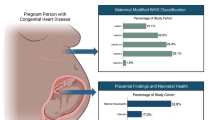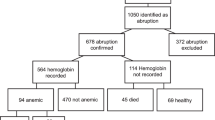Abstract
Objective:
To compare the clinical characteristics and placental histopathology between pregnancies complicated by placenta previa and controls.
Study Design:
Between 2009 and 2015, cesarean deliveries (CDs) of 119 pregnancies with placenta previa were identified from which maternal outcomes, neonatal outcomes and placental pathology were reviewed. Results were compared with CDs matched for maternal age and pregnancy complications (control group, n=119). Placental lesions were classified into maternal and fetal vascular supply lesions and inflammatory response. Composite neonatal outcome was defined as one or more of early neonatal complications. Small-for-gestational age (SGA) was defined as birth weight ⩽10th percentile.
Results:
Placentas from the previa group had higher rates of weights <10th percentile (P<0.001) and of maternal and fetal vascular supply lesions (P<0.001, for both). Higher rate of SGA (P=0.003) and worse composite neonatal outcome (P<0.001) were also observed in the previa group as compared with controls. After controlling for potential confounding bias using multivariable logistic regression models, placenta previa remained statistically significantly associated with placental maternal (adjusted odds ratio (aOR) 2.48, 95% confidence interval (CI) 1.2–4.9, P=0.009) and fetal (aOR 7.05, 95% CI 2.4–20.2, P<0.001) vascular supply lesions, SGA (aOR 10, 95% CI 2.3–44.2, P=0.002) and adverse neonatal outcome (aOR 6.87, 95% CI 2.9–11.8, P<0.001).
Conclusions:
More placental vascular supply lesions, higher rate of SGA and worse neonatal outcome characterized pregnancies with placenta previa in the current study. These findings may suggest that abnormal placentation is accompanied by suboptimal implantation that interferes with fetal growth.
This is a preview of subscription content, access via your institution
Access options
Subscribe to this journal
Receive 12 print issues and online access
$259.00 per year
only $21.58 per issue
Buy this article
- Purchase on Springer Link
- Instant access to full article PDF
Prices may be subject to local taxes which are calculated during checkout
Similar content being viewed by others
References
Taipale P, Hiilesmaa V, Ylostalo P . Diagnosis of placenta previa by transvaginal sonographic screening at 12-16 weeks in a nonselected population. Obstet Gynecol 1997; 89 (3): 364–367.
Oyelese Y . Placenta previa: the evolving role of ultrasound. Ultrasound Obstet Gynecol 2009; 34 (2): 123–126.
Oyelese Y, Smulian JC . Placenta previa, placenta accreta, and vasa previa. Obstet Gynecol 2006; 107 (4): 927–941.
Getahun D, Oyelese Y, Salihu HM, Ananth CV . Previous cesarean delivery and risks of placenta previa and placental abruption. Obstet Gynecol 2006; 107 (4): 771–778.
Ananth CV, Smulian JC, Vintzileos AM . The association of placenta previa with history of cesarean delivery and abortion: a metaanalysis. Am J Obstet Gynecol 1997; 177 (5): 1071–1078.
Ananth CV, Wilcox AJ, Savitz DA, Bowes WA Jr., Luther ER . Effect of maternal age and parity on the risk of uteroplacental bleeding disorders in pregnancy. Obstet Gynecol 1996; 88 (4 Pt 1): 511–516.
Macones GA, Sehdev HM, Parry S, Morgan MA, Berlin JA . The association between maternal cocaine use and placenta previa. Am J Obstet Gynecol 1997; 177 (5): 1097–1100.
Ananth CV, Demissie K, Smulian JC, Vintzileos AM . Placenta previa in singleton and twin births in the United States, 1989 through 1998: a comparison of risk factor profiles and associated conditions. Am J Obstet Gynecol 2003; 188 (1): 275–281.
Rosenberg T, Pariente G, Sergienko R, Wiznitzer A, Sheiner E . Critical analysis of risk factors and outcome of placenta previa. Arch Gynecol Obstet 2011; 284 (1): 47–51.
Faiz AS, Ananth CV . Etiology and risk factors for placenta previa: an overview and meta-analysis of observational studies. J Matern Fetal Neonatal Med 2003; 13 (3): 175–190.
Norgaard LN, Pinborg A, Lidegaard O, Bergholt T . A Danish national cohort study on neonatal outcome in singleton pregnancies with placenta previa. Acta Obstet Gynecol Scand 2012; 91 (5): 546–551.
Crane JM, Van den Hof MC, Dodds L, Armson BA, Liston R . Maternal complications with placenta previa. Am J Perinatol 2000; 17 (2): 101–105.
Rao KP, Belogolovkin V, Yankowitz J, Spinnato JA 2nd . Abnormal placentation: evidence-based diagnosis and management of placenta previa, placenta accreta, and vasa previa. Obstet Gynecol Surv 2012; 67 (8): 503–519.
Spong CY, Mercer BM, D'Alton M, Kilpatrick S, Blackwell S, Saade G . Timing of indicated late-preterm and early-term birth. Obstet Gynecol 2011; 118 (2 Pt 1): 323–333.
Raisanen S, Kancherla V, Kramer MR, Gissler M, Heinonen S . Placenta previa and the risk of delivering a small-for-gestational-age newborn. Obstet Gynecol 2014; 124 (2 Pt 1): 285–291.
Neri A, Gorodesky I, Bahary C, Ovadia Y . Impact of placenta previa on intrauterine fetal growth. Isr J Med Sci 1980; 16 (6): 429–432.
Ananth CV, Demissie K, Smulian JC, Vintzileos AM . Relationship among placenta previa, fetal growth restriction, and preterm delivery: a population-based study. Obstet Gynecol 2001; 98 (2): 299–306.
Kassem GA, Alzahrani AK . Maternal and neonatal outcomes of placenta previa and placenta accreta: three years of experience with a two-consultant approach. Int J Womens Health 2013; 5: 803–810.
Yeniel AO, Ergenoglu AM, Itil IM, Askar N, Meseri R . Effect of placenta previa on fetal growth restriction and stillbirth. Arch Gynecol Obstet 2012; 286 (2): 295–298.
Harper LM, Odibo AO, Macones GA, Crane JP, Cahill AG . Effect of placenta previa on fetal growth. Am J Obstet Gynecol 2010; 203 (4): 330 e1–330 e5.
Wolf EJ, Mallozzi A, Rodis JF, Egan JF, Vintzileos AM, Campbell WA . Placenta previa is not an independent risk factor for a small for gestational age infant. Obstet Gynecol 1991; 77 (5): 707–709.
Crane JM, van den Hof MC, Dodds L, Armson BA, Liston R . Neonatal outcomes with placenta previa. Obstet Gynecol 1999; 93 (4): 541–544.
Redline RW . Placental pathology: a systematic approach with clinical correlations. Placenta 2008; 29 (Suppl A): S86–S91.
Redline RW, Heller D, Keating S, Kingdom J . Placental diagnostic criteria and clinical correlation—a workshop report. Placenta 2005; 26 (Suppl A): S114–S117.
Reddy UM, Abuhamad AZ, Levine D, Saade GR, Fetal Imaging Workshop Invited Participants. Fetal imaging: executive summary of a joint Eunice Kennedy Shriver National Institute of Child Health and Human Development, Society for Maternal-Fetal Medicine, American Institute of Ultrasound in Medicine, American College of Obstetricians and Gynecologists, American College of Radiology, Society for Pediatric Radiology, and Society of Radiologists in Ultrasound Fetal Imaging Workshop. J Ultrasound Med 2014; 33 (5): 745–757.
American College of Obstetricians and Gynecologists Women's Health Care Physicians. ACOG Practice Bulletin No. 138: inherited thrombophilias in pregnancy. Obstet Gynecol 2013; 122 (3): 706–717.
American College of Obstetricians and Gynecologists Committee on Practice Bulletins-Obstetrics. ACOG Practice Bulletin No. 118: antiphospholipid syndrome. Obstet Gynecol 2011; 117 (1): 192–199.
Dollberg S, Haklai Z, Mimouni FB, Gorfein I, Gordon ES . Birth weight standards in the live-born population in Israel. Isr Med Assoc J 2005; 7 (5): 311–314.
Weiner E, Bar J, Fainstein N, Schreiber L, Ben-Haroush A, Kovo M . Intraoperative findings, placental assessment and neonatal outcome in emergent cesarean deliveries for non-reassuring fetal heart rate. Eur J Obstet Gynecol Reprod Biol 2015; 185: 103–107.
Pinar H, Sung CJ, Oyer CE, Singer DB . Reference values for singleton and twin placental weights. Pediatr Pathol Lab Med 1996; 16 (6): 901–907.
Strong TH Jr., Jarles DL, Vega JS, Feldman DB . The umbilical coiling index. Am J Obstet Gynecol 1994; 170 (1 Pt 1): 29–32.
Redline RW . The clinical implications of placental diagnoses. Semin Perinatol 2015; 39 (1): 2–8.
Redline RW . Classification of placental lesions. Am J Obstet Gynecol 2015; 213 (4 Suppl): S21–S28.
Papinniemi M, Keski-Nisula L, Heinonen S . Placental ratio and risk of velamentous umbilical cord insertion are increased in women with placenta previa. Am J Perinatol 2007; 24 (6): 353–357.
Chan JS, Baergen RN . Gross umbilical cord complications are associated with placental lesions of circulatory stasis and fetal hypoxia. Pediatr Dev Pathol 2012; 15 (6): 487–494.
Heidari Z, Sakhavar N, Mahmoudzadeh-Sagheb H, Ezazi-Bojnourdi T . Stereological analysis of human placenta in cases of placenta previa in comparison with normally implanted controls. J Reprod Infertil 2015; 16 (2): 90–95.
Biswas R, Sawhney H, Dass R, Saran RK, Vasishta K . Histopathological study of placental bed biopsy in placenta previa. Acta Obstet Gynecol Scand 1999; 78 (3): 173–179.
Salafia CM, Vintzileos AM, Silberman L, Bantham KF, Vogel CA . Placental pathology of idiopathic intrauterine growth retardation at term. Am J Perinatol 1992; 9 (3): 179–184.
Kovo M, Schreiber L, Ben-Haroush A, Cohen G, Weiner E, Golan A et al. The placental factor in early- and late-onset normotensive fetal growth restriction. Placenta 2013; 34 (4): 320–324.
Sander CH, Kinnane L, Stevens NG . Hemorrhagic endovasculitis of the placenta: a clinicopathologic entity associated with adverse pregnancy outcome. Compr Ther 1985; 11 (5): 66–74.
Redline RW . Severe fetal placental vascular lesions in term infants with neurologic impairment. Am J Obstet Gynecol. 2005; 192 (2): 452–457.
McIntire DD, Leveno KJ . Neonatal mortality and morbidity rates in late preterm births compared with births at term. Obstet Gynecol 2008; 111 (1): 35–41.
Yoder BA, Gordon MC, Barth WH Jr . Late-preterm birth: does the changing obstetric paradigm alter the epidemiology of respiratory complications? Obstet Gynecol 2008; 111 (4): 814–822.
Consortium on Safe Labor, Hibbard JU, Wilkins I, Sun L, Gregory K, Haberman S et al. Respiratory morbidity in late preterm births. JAMA 2010; 304 (4): 419–425.
Romero R, Dey SK, Fisher SJ . Preterm labor: one syndrome, many causes. Science 2014; 345 (6198): 760–765.
Ghidini A, Salafia CM . Histologic placental lesions in women with recurrent preterm delivery. Acta Obstet Gynecol Scand 2005; 84 (6): 547–550.
Author information
Authors and Affiliations
Corresponding author
Ethics declarations
Competing interests
The authors declare no conflict of interest.
Rights and permissions
About this article
Cite this article
Weiner, E., Miremberg, H., Grinstein, E. et al. The effect of placenta previa on fetal growth and pregnancy outcome, in correlation with placental pathology. J Perinatol 36, 1073–1078 (2016). https://doi.org/10.1038/jp.2016.140
Received:
Revised:
Accepted:
Published:
Issue Date:
DOI: https://doi.org/10.1038/jp.2016.140
This article is cited by
-
Risk Factors and Pregnancy Outcomes of Antepartum Hemorrhage in Women with Placenta Previa
Reproductive Sciences (2023)
-
Effect of previous placenta previa on outcome of next pregnancy: a 10-year retrospective cohort study
BMC Pregnancy and Childbirth (2020)
-
Cumulative Antenatal Risk and Kindergarten Readiness in Preterm-Born Preschoolers
Research on Child and Adolescent Psychopathology (2020)
-
Amniotic fluid transitioning from clear to meconium stained during labor—prevalence and association with adverse maternal and neonatal outcomes
Journal of Perinatology (2019)



